Negative reviews are a little bit like chickenpox. You don't want them, but chances are, you’re going to get them at some point.
Just like pox, if you don't deal with them properly when they arise, they have the potential to leave lifelong scars on your business and brand.
The best thing you can do is be prepared for them.
Even if you're delivering streamlined, 'above and beyond' services, at some point, you will catch a customer on an off day, and they'll leave a bad review online, where everyone (including your potential customers and potential employees) can see it.
When this happens, don’t panic.
Negative reviews don’t have to be the monsters that many companies make them out to be. In fact, by handling a negative review with a winning response, you can convert even the most sceptical readers and show the world your commitment to courtesy, professionalism, and superior service, even under fire.
Things to remember when you're crafting your response to a negative review
When replying to negative reviews, it's important to keep a positive frame of mind and adopt a constructive approach to address the concerns of the reviewer. This mindset will help your positive brand image and professionalism shine through.
Your tone should be calm, respectful, and on-brand. Avoid being defensive or argumentative because this can escalate the situation. Keep your response concise and to the point, but be sure to address all the relevant points of the reviewer's feedback.
Remember that you're not just writing a reply to the reviewer. You're writing a reply to prospective customers who are reading your reviews as well.
A step-by-step process for responding to negative reviews
Step 1: Open with an appropriate greeting
Start with a greeting that matches the tone of your business and the tone of the review. It’s usually a good idea to address them by their name if it’s given.
If their review is super negative, you don’t want to come off as condescending or impersonal, so while starting with “Dear” might be good in other circumstances, we wouldn’t recommend it here. Stick with "Hello/Hi/Hey [customer name]", or even "I'm sorry to hear that, [customer name]".
Step 2: Acknowledge the problem quickly
If they mention specifics about what prompted their negative review, try to address them quickly in your response and empathise with why that would be upsetting.
This shows that you have read their feedback, that you value their opinion and are taking their concern seriously.
Try something like: "Sorry to hear that you experienced X. I completely understand why that would annoy you".
Step 3: Offer a sincere apology
Make it clear that you’re accepting responsibility for their troubles, even if your initial reaction is to try and distance yourself (a normal response to negative feedback).
It’s important to take responsibility, even if it’s not necessarily your fault—this will go a long way toward defusing anger and building trust, both with the unhappy customer and with prospective customers who are reading your reply.
For example, "We apologise that we did not meet your expectations on X.”
Step 4: Say thank you
While a negative review is frustrating, it's a better idea to look at the situation as "glass half full".
A negative review offers a chance to save the customer and helps identify problems you weren't aware of, and a skilful response gives you the chance to show readers how committed you are to customer service.
The next step is to thank the customer for bringing the issue to your attention. Tell them you’re glad they reached out to leave a negative review because it allowed you to identify and resolve a pain point.
Step 5: Explain, but don’t make excuses
If you can provide an explanation that doesn’t feel like you’re making excuses, it's best to do so, but only after you’ve acknowledged and apologized for the experience. If you try to explain before you take responsibility and apologize, the reviewer is going to be much less receptive to your reasoning.
Here’s one approach: "We completely understand your frustration. We looked into what happened here, and it turns out that one of our trucks was in an accident and couldn’t deliver your order on time. We're sorry we didn’t have a contingency plan in place to get you what you needed.”
Step 6: Offer a solution
This step depends entirely on the issue the customer has raised, but if possible, try to offer a solution to the problem. This could involve a refund, a revisit, or a discount on their next service—anything you can do to demonstrate that you’re committed to making up for this customer’s bad experience.
“We’d like you to try us again on a much better day and have a 15% coupon to make up for your previous experience."
Step 7: Ask for a second chance
Ask them if they’d be open to giving you another chance. This is a critical step that demonstrates your commitment to their satisfaction.
“Is there any chance you’d be willing to give us another shot at delivering the quality we’re usually known for?”
Step 8: Take meaningful action to address the problem
More than anything, people who leave negative reviews want to know that something will be done to make sure it won't happen again.
This shows that you have listened and that their efforts have led to a positive outcome, which is hugely validating. Highlight any steps you're taking to prevent similar issues from occurring again.
“Bringing the problem to our attention has helped us fix it by introducing some new training with our team. We're grateful for your feedback.”
Step 9: Invite further discussion offline
Encourage the reviewer to reach out to you directly if they have any further questions or details that might help you solve their problem. Providing contact information or a customer service email can show that you're dedicated to righting the wrong.
Step 10: Remember to sign off
End the reply with your name to add a personal touch and make the response more genuine.
In summary
There are so many companies that like to ignore or argue against bad reviews. Don’t fall into this trap! Instead, approach them as an opportunity to connect and empathise with your customers, address any oversights or shortcomings in your business, and impress prospective customers who may read the exchange.
Now that you’ve got the goods on handling negative reviews, find out how to get more great reviews by downloading our guide on how to ethically explode your Google reviews.
After all, the best way to prepare for negative reviews is to have an abundance of positive ones—making them a needle in a haystack.



